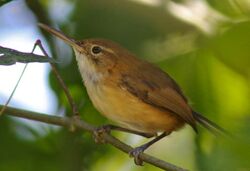Biology:Long-billed gnatwren
| Long-billed gnatwren | |
|---|---|

| |
| Scientific classification | |
| Kingdom: | |
| Phylum: | |
| Class: | |
| Order: | |
| Family: | |
| Genus: | Ramphocaenus Vieillot, 1819
|
| Species: | R. melanurus
|
| Binomial name | |
| Ramphocaenus melanurus (Vieillot, 1819)
| |
The long-billed gnatwren (Ramphocaenus melanurus) is a very small bird in the gnatcatcher family. It is the only member of the genus Ramphocaenus (Vieillot, 1819), which means ‘unusual beak’, from the Ancient Greek rhamphos (ῥάµϕος, ‘beak’)[2] and cænos (καινός, ‘strange’).[3]
Habitat
It is found in the undergrowth and vines of dry forest and secondary woodland from Mexico south to Peru and Brazil , and on Trinidad.
Long-billed gnatwrens build a deep cup nest very low in a small plant or sapling. The two white eggs are incubated by both parents for 16–17 days to hatching, with a further 11–12 days to fledging.
Description
Adult long-billed gnatwrens are 10.9 cm long and weigh 10.3 g. They have a long, thin bill and a short cocked tail. The upperparts are grey-brown, with rufous on the sides of the head. The throat is white, shading to buff on the rest of the underparts. The tail is black with white tips to all but the central feathers, and is frequently wagged.
R. m. trinitatis, of eastern Colombia, Venezuela and Trinidad has paler underparts, and buff flanks and head sides.
Diet
Long-billed gnatwrens forage actively in vegetation, eating mainly insects, insect eggs and spiders. The call is a trilled drdrdrdrdrdrdrdrdrdr. This unmistakable bird usually occurs in pairs or family groups.
References
- ↑ Template:IUCN
- ↑ rhamphoid (3rd ed.), Oxford University Press, September 2005, http://oed.com/search?searchType=dictionary&q=rhamphoid (Subscription or UK public library membership required.)
- ↑ Jobling, James A. (2010). Helm Dictionary of Scientific Bird Names. A & C Black. p. 330. ISBN 978-1-4081-2878-7. "Gr. rhamphos bill; kainos novel, strange."
- Birds of Venezuela by Hilty, ISBN:0-7136-6418-5
- ffrench, Richard (1991). A Guide to the Birds of Trinidad and Tobago (2nd ed.). Comstock Publishing. ISBN 0-8014-9792-2.
External links
- Long-billed Gnatwren videos on the Internet Bird Collection
- Long-billed Gnatwren photo gallery VIREO
Wikidata ☰ Q377733 entry


